Kolomenskoye
The history of Kolomenskoye is intertwined with the history of the Russian monarchy. It was a home for Peter the Great during his early years. It was the scene of festivities marking the coronations of Catherine I, Peter II and Empresses Anna and Elizabeth. Peter II often hunted in the woods nearby, and in the late 18th century Catherine the Great used to come here with her grandchildren, including the future Emperor Alexander I.
Pictures by Joost Lemmens
The first document to mention the village of Kolomenskoye is the will chart of Moscow’s Grand Duke Ivan Kalita from 1339. But its history dates from around 1240 when the inhabitants of Kolomna, seeking refuge from the Tatar-Mongol invaders led by Batu Khan, a grandson of Jenghiz Khan, founded a settlement here.
From the 14th century on, Kolomenskoye was the family estate of the Grand Dukes of Muscovy and later the Tsars of Russia.
The luxurious chambers of Vasily III (1479-1533, Grand Duke of Moscow 1505-33) burned down during a raid by Khan Mukhammed Girei I of Crimea.
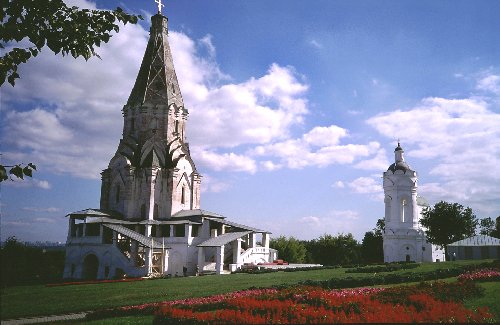
In 1532 Vasily III built the church of the Ascension in the village of Kolomenskoye, to commemorate the birth of his son Ivan IV.
It was the first known stone church in the Russian kokoshnik, or tent style. Some researchers think that foreigners participated in its construction, in particular the Italian Petrok Maliy (“Little Peter”), who was later to gain fame for, among other things, erecting the Kitaigorod wall.
Ivan IV the Terrible (1530-1584) lived here as a child, and later with his first wife Anastasia.
In 1606, during the so-called Time of Troubles, the troops of Ivan Bolotnikov, leader of the first Russian peasant uprising, pitched camp here when they laid siege to the capital for five weeks.
Unfortunately, the wooden palace of Tsar Alexei Mikhailovich, a unique masterpiece of Russian architecture built in 1667-1668 by carpenter foreman Semen Petrov and serf carpenter Ivan Mikhailov, has not survived. This beautiful palace, considered by its Russian contemporaries to be the “Eight wonder of the world”, consisted of a large number of buildings interconnected by passageways. The entire ensemble must had been very impressive with all its towers, cupolas, Kokoshniks, ogee-shaped roofs, spires, globes, gilded double headed eagles etc.
Today the visitors to the museum can form an idea of what the palace looked like from the model skilfully executed by the woodcarver D. Smirnov in 1867.
The young Peter I the Great was taken to Kolomenskoye during the Streltsy riot of 1682. Later, as tsar, he returned several times. Partly because of changes in taste, and because the capital had been moved from Moscow to Saint Petersburg, the palace was neglected and the old wooden structure became unsafe for living. In 1769 Catherine II ordered it to be taken down.
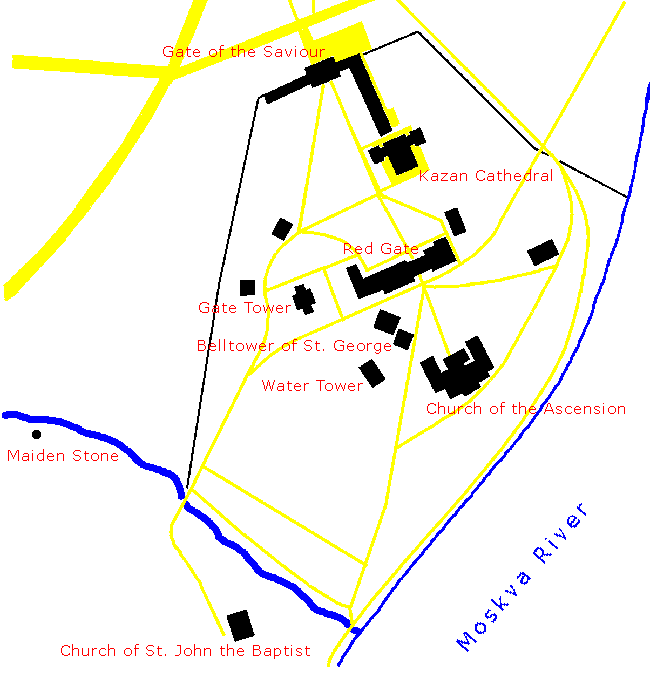
Coming from Kolomenskoye Metro station, one enters
the park through the Gate of the Saviour.
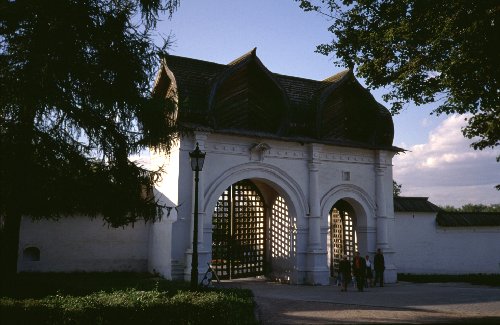 |
Erected in the
1670’s as a servants entrance, it is of rather modest design. Its shingled
wooden barrel-like roof is a characteristic element of
16th-17th century Russian architecture. Before 1917,
there was an icon of the Saviour above the arches, hence its
name.
|
Gate of the Saviour
|
|
Walking into the grounds, the first building one passes is the elegant Kazan Cathedral.
Built by Tsar Alexei in 1649-1653 to commemorate the centenary of the capture of Kazan by Ivan the Terrible, it is of typical 17th century style. Atop the arched first story sits a solid four-walled structure, crowned by five cupola-topped cylinders. |
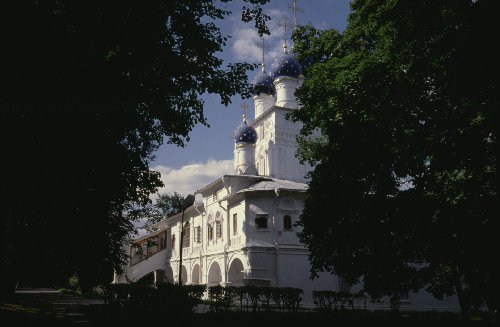 |
Kazan Cathedral
|
|
Continuing through the park with its centuries-old oak trees, one may take a look at some of the old wooden buildings brought here from different regions of Russia, like the Bratsk, Siberia fortress tower, the Arkhangelsk cabin of Peter I, or the monastery gate-tower from Karelia.
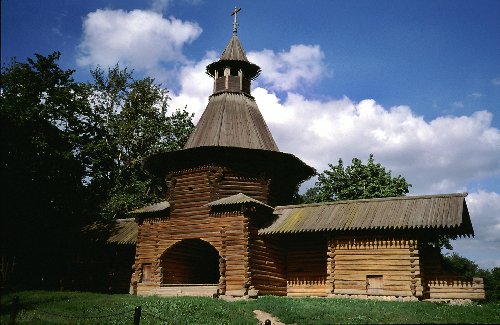 |
Gate Tower of the St. Nicholas Monastery from the White Sea coast of north-western Russia; built 1691-1692. |
Gate Tower
|
|
Following the path through the oak grove, the main entrance or Red Gate lies straight ahead.
The Red Gate was the main entrance to the Royal Palaces. Its construction dates from 1672-1673. The buildings on its sides house exhibits about the history of Kolomenskoye, as well as an extensive collection of Russian applied art |
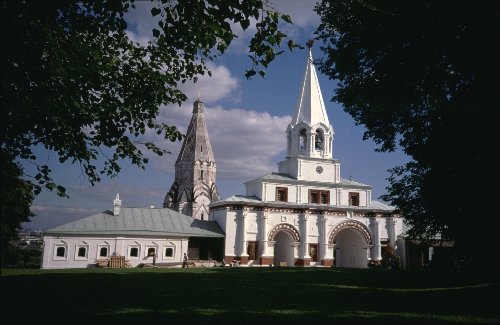 |
Red Gate
|
|
The design of one of the most remarkable buildings of Moscow, the Church of the Ascension (1530-1532) was at its time a radical departure from the traditional Byzantine style. Immediately after it was built, a contemporary chronicler recorded the event in impassioned words, noting that no other church in Russia rivalled its beauty.
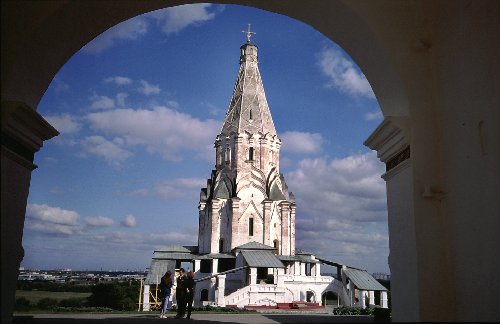 | The Church of the Ascension is known as the Russia’s first stone tent-roofed church. Its sweeping silhouette resembles the magnificent wooden tower-like churches erected by Russian carpenters. |
Church of the Ascension
|
|
In contrast to traditional domed cruciform churches, the Church of the Ascension was created in the form of a gigantic pillar and has neither supporting columns nor piers.
The entire weight of the building presses against the walls, which are 2,5 to 3 metres thick. The height of the church is 62 metres. |
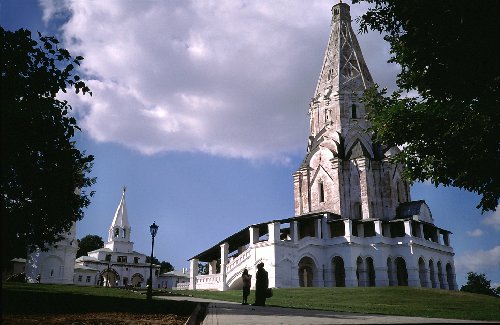 |
Church of the Ascension
|
|
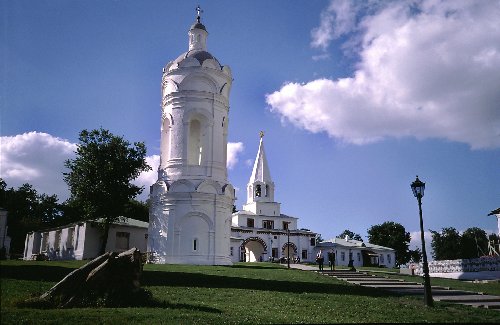 |
The circular bell-tower of St.George the Victorious was built in the first half of the 16th century by an unknown architect. |
Bell Tower of Saint George
|
|
Somewhat outside the Royal Court stands The Water Tower, constructed in the 1670’s.
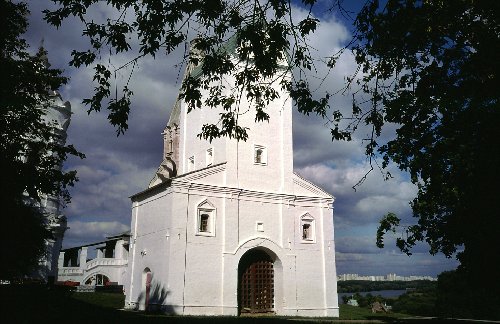 | Inside was a mechanism created by the master Bogdan Puchin. From a deep well dug beneath the tower the water was pumped upwards into a white-stone reservoir, and from there to the Royal Court. |
Water Tower
|
|
Once a road led through the Water Tower towards the
village of Dyakovo on the other side of the beautiful Golosov Ravine, with its
unique geological formations, a group of springs called “Kadochka” or little water-bowl, and two large earth-settled stones which were objects of pagan worship.
This is the largest of the two prehistoric cult stones near the springs, the so-called “Maiden Stones”. |
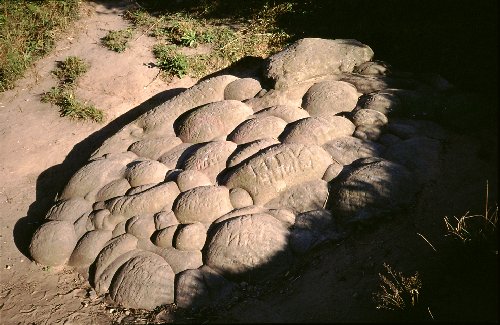 |
Maiden Stone
|
|
Some 2.500 years ago a settlement appeared on the site of the village of Dyakovo, making it one of the oldest inhabited places in the Moscow region.
There are no existing records regarding the date of construction of the Church of the Beheading of St.John the Baptist, but researchers believe that the church may have been built in connection with the coronation of Ivan the Terrible in 1547, or for the expected birth of his son in 1554.
It is a tower-like church without internal supports, designed as a central octagon, flanked by four smaller octagonal chapels. The central tower, measured without its cross, is 34.5 metres high. |
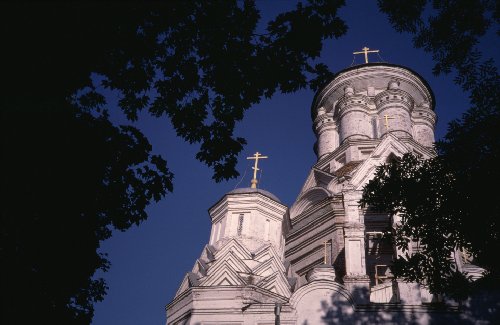 |
Church of St. John the Baptist
|
|
The Cathedral of St. Basil on Moscow’s Red Square, which was constructed in 1555-1561, comes closest architecturally to the Church of St.John. The similarity of structural, compositional and decorative elements suggests that both buildings may have been constructed by the same architects, known as Barma and Postnik.
After the Revolution, the villages of Kolomenskoye and
Dyakovo were destroyed through collectivisation, the cemeteries razed and
churches closed. In the 1930’s the Museum of Wooden Architecture was founded,
and finally, in 1974 some 400 hectares were declared a conservation zone.
Home |
Next Page: Tsaritsyno >>
Links
My Other Pages:
Mail:











